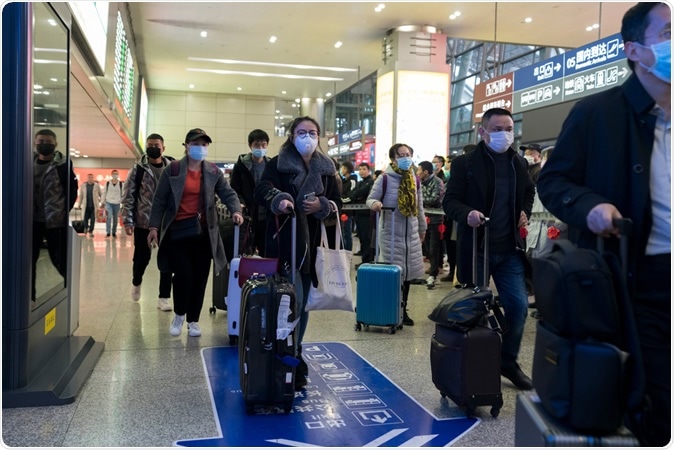The coronavirus disease (COVID-19) outbreak has now spread outside China, affecting 47 countries. The worst-hit countries are strengthening their efforts to contain the deadly coronavirus as the number of confirmed infections globally surpassed 81,000. Amid the health crisis, Americans are being urged to prepare for a possible outbreak spread.
The number of confirmed cases in the United States increased to 59, most of whom were repatriated from Wuhan, China, and the Diamond Princess cruise ship, which had was quarantined in Japan. Of those 59, six have made a full recovery.

Chengdu, Sichuan / China - Travellers wear masks at airport to prevent infection from coronavirus. Image Credit: B.Zhou / Shutterstock
Prepare for coronavirus
The U.S. Centers for Disease Control and Prevention (CDC) officials issued a warning to all residents in the United States to prepare for the coronavirus spread, after South Korea, Iran, and Italy reported a rapid uptick in confirmed cases.
"We want to prepare the American public for the possibility that their lives will be disrupted because of this pandemic," Dr. Nancy Messonnier, director of the CDC's National Center for Immunization and Respiratory Diseases, said.
"It's not so much a question of if this will happen anymore, but more really a question of when it will happen — and how many people in this country will have a severe illness," Dr. Messonnier added.
Though the World Health Organization (WHO) has not yet classified the current outbreak as a pandemic, the sharp increase in cases and spread to many countries has sparked concern and fears across the globe.
"We are not witnessing the uncontained global spread of this virus. What we are seeing are epidemics in different parts of the world, affecting countries in different ways," Dr. Tedros Adhanom Ghebreyesus, WHO's director-general, said during a news conference.
Aggressive measures needed
Dr. Messonnier said that though aggressive measures such as travel bans were imposed to prevent the spread of the virus in the U.S., more invasive steps are necessary, which could include workplace shutdowns, canceling significant events and gatherings, and school closings.
She added that though these measures can disrupt schools, work, and the everyday lives of people, they should start thinking about these now. Further, Americans may start working at home temporarily, and schools should consider dividing students into smaller groups or close while opting for internet-based tele-schooling.
"For adults, businesses can replace in-person meetings with video or telephone conferences and increase teleworking options," Messonnier said.
However, she stressed that the current risk is still low since all the cases in the country were among travelers who returned from overseas. Further, she estimates that by spring or summer, the number of cases may decline.
Which states have confirmed cases so far?
The cases of coronavirus in the U.S. have reached 57, 12 of those cases are travel-related, 43 cases were from those repatriated from Wuhan, China, or the Diamond Princess cruise ship, while two cases are the result of person-to-person transmission in the country.
So far, seven patients have recovered, one in Washington, one in Arizona, two in Illinois, and three in California. The states reporting confirmed cases include Texas, California, Washington, Illinois, Arizona, Massachusetts, and Wisconsin.
What is being done?
So far, the U.S. government is restricting U.S. citizens who have been to Hubei province, the epicenter of the deadly outbreak, in the last two weeks before they returned to the U.S. Further, they will have to go through a mandatory quarantine of up to 14 days.
The CDC urges people to follow the flu season protocol, which includes washing the hands with soap and water for 20 seconds, staying at home, avoiding ill people, and avoiding going out in the public when they are sick. The CDC, however, does not recommend wearing surgical masks in public, since they are not effective for airborne infections.